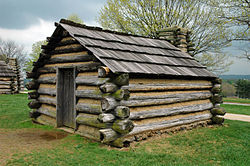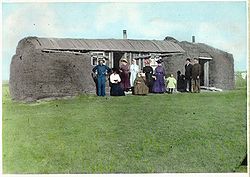AY Honors/Pioneering/Answer Key
1. Describe in writing, orally, or with pictures how the early pioneers met the following basic living needs:
a. Housing and furnishings
Housing
The first European settlers in the New World came from England, and brought English building practices with them. In England, timber was scarce, and the building techniques reflected that scarcity. This really made little sense, because the East Coast of the New World where they settled was literally covered with timber. When the Swedes arrived around 1640, they introduced the log cabin. Compared to other house-building techniques, log cabin construction saved a lot of labor. Logs needed to be debarked, cut to length, and notched where they made joints. They did not need to be sawn into planks.
The log cabin served the pioneers well until they pushed into the Great Plains where trees again were scarce. Settlers in the plains turned to the most abundant building material available to them - sod. They would cut from the ground rectangles of sod measuring about 600×300×150mm![]() , and pile them into walls. The resulting structure was a well-insulated but damp dwelling that was very inexpensive. Sod houses required frequent maintenance and were vulnerable to rain damage. Stucco or wood panels often protected the outer walls. Canvas or plaster often lined the interior walls.
, and pile them into walls. The resulting structure was a well-insulated but damp dwelling that was very inexpensive. Sod houses required frequent maintenance and were vulnerable to rain damage. Stucco or wood panels often protected the outer walls. Canvas or plaster often lined the interior walls.
Furnishings
b. Clothing
c. Food
d. Cooking
e. Warmth and light
f. Tools and handiwork
g. Sanitation
h. Transportation
2. Construct a piece of useful furniture by lashing. Learn the following lashings:
a. Square
Adventist Youth Honors Answer Book/Lashing/Square
b. Diagonal
Adventist Youth Honors Answer Book/Lashing/Diagonal
c. Sheer
Adventist Youth Honors Answer Book/Lashing/Sheer
d. Continuous
Adventist Youth Honors Answer Book/Lashing/Continuous
3. Do one of the following:
a. Weave a basket using natural materials.
See the Basketry honor for instruction.
b. Make a pair of leather moccasins
c. Make a lady's bonnet by hand sewing.
d. Make a simple toy used by the pioneers.
4. Know how to make flour from at least one wild plant for use in baking.
Flour can be made from clover blossoms. Gather about 8 liters![]() of them and let them dry for two weeks. You can also put them in a low temperature oven for an hour or two. Once they are dry, grind them to powder with a mortar and pestle. This will make about 250 ml
of them and let them dry for two weeks. You can also put them in a low temperature oven for an hour or two. Once they are dry, grind them to powder with a mortar and pestle. This will make about 250 ml![]() of flour. Mix half-and-half with wheat flour. It makes good pancakes.
of flour. Mix half-and-half with wheat flour. It makes good pancakes.
You can also make flour with acorns (it's a lot of work), and the roots or pollen of cattail. See the answers to the Edible Wild Plants honor for details.
5. Build a fire without matches. Use natural fire building materials. Keep the fire going for five minutes. You may use the following to start your fire:
a. Flint and steel
Adventist Youth Honors Answer Book/Camping/Fire/Flint and steel
b. Friction
Adventist Youth Honors Answer Book/Camping/Fire/Friction
c. Electric spark
Adventist Youth Honors Answer Book/Camping/Fire/Electric spark
d. Curved glass
Adventist Youth Honors Answer Book/Camping/Fire/Curved glass
e. Metal match
Adventist Youth Honors Answer Book/Camping/Fire/Metal match
f. Compressed air
Adventist Youth Honors Answer Book/Camping/Fire/Compressed air
6. Show axmanship knowledge in the following:
a. Describe the best types of axes.
b. Show how to sharpen an ax properly.
It is best to sharpen an axe by hand rather than using an electric grinder. A grinder will heat the blade and ruin the axe's temper. This will cause the bit to soften making it impossible for the axe to hold a sharp edge during typical use. If the axe is very dull or has visible notches in the blade, start sharpening with a file. The file should be held at an angle and run over the length of the blade. Sharpen both sides until the notches are gone. If the axes just needs a touch-up, you can use a sharpening stone. Wet the stone with water (or if you have an oilstone, with oil). This will cause the filings to "float" away an prevent them from clogging the pores in the stone (making it smoother and thus, less effective at sharpening).
c. Know and practice safety rules in the use of an ax.
Be sure you have firm footing before swinging an axe or a hatchet, and be sure no one is within six feet of you to the sides or to the rear, and within twelve feet of you towards your front. Axe heads have come off before (2 Kings 6:5), and they are very dangerous when they do. When handing an axe to another person, offer them the handle. Carry the axe so that if you were to trip, the blade would point away from you. Put the axe in a sheath (if it has one) when it is not in use.
d. Know the proper way to use an ax.
Do not hammer an axe into a piece of wood. An axe is for cutting, and should not be used as a wedge. It should also not be used as a sledge hammer. Practice aiming the axe until you get good at it. When you can hit what you aim at, your use of the axe will be far more efficient. Do not chop into the ground - this practice will quickly dull an axe. Apply a bit of oil to the axehead to prevent rust.
e. Properly cut in two a log at least eight inches (20.3 cm) thick.
Do not lay the log directly on the ground. Otherwise the axe blows will push the log into the ground. Instead, lay it on another small log (three inches in diameter is good). Strike the log to be cut at the point where it is in contact with the supporting log. Otherwise, the log may flip up and strike you or a bystander. This can cause a serious injury, so be watchful. Proceed by chopping a "vee" into the log, alternating cuts on the left and on the right. The width of the vee should be equal to the diameter of the log. Once the vee penetrates halfway through the log, turn it over and cut another on the opposite side until the two vees meet.
f. Properly split wood that is at least eight inches (20.3 cm) in diameter and one foot (30.5 cm) long.
Adventist Youth Honors Answer Book/Camping/Splitting firewood
7. Do two of the following:
a. Make a ten-foot (3.0 meters) rope from natural material or twine.
Adventist Youth Honors Answer Book/Knots/Making rope
b. Tie ten knots useful to the pioneer and tell how they were used.
1. Bowline
2. Bowline on a bight
Template:Knot bowline on a bight
3. Clove hitch
4. Double fisherman's
Template:Knot double fishermans
5. Figure eight
6. Prusik
7. Sheepshank
8. Square
9. Taut-line hitch
10. Two half hitches
Template:Knot two half hitches
c. Using rope and natural materials, make one device for moving heavy objects.
d. Construct an adequate and comfortable latrine.
Adventist Youth Honors Answer Book/Camping/Latrine
8. Explain the need for proper sanitation relating to solid and human waste and the washing of body, clothes, and dishes.
9. Assist in the construction of a ten-foot (3.0 meters) long log or rope bridge, using lashings.
10. Know four ways to keep the wilderness beautiful.
11. Do two of the following:
a. Make a wax candle or other form of pioneer light source.
See the Candlemaking honor for instruction. Why not earn it while you're at it?
b. Make a batch of soap.
Note that this is also a major requirement for the Soap Craft - Advanced honor.
Adventist Youth Honors Answer Book/Making soap
c. Milk a cow.
Adventist Youth Honors Answer Book/Milk a cow
d. Churn butter.
This can be done when sitting around the campfire. Get a half pint of heavy cream and place it in a sealable container with a wide mouth, such as a Tupperware vessel. Place a marble (or similar object) in the container with the cream and seal it up tight. Then pass it around the campfire having everyone shake it for a minute or two. After ten to fifteen minutes, the container should have two things in it: butter, and buttermilk. You can pour off the buttermilk (save it for biscuits or pancakes in the morning) and you are left with solid butter. Delicious!
e. Make a quill pen and write with it.
If you don't happen to have a flock of geese from which to pluck feathers, you can always buy them at a craft supply store. Select a feather that is about 30 cm![]() long. The first step in making a quill pen is to temper the shaft. This can be done by heating a tin can filled with sand in an oven at 175°C
long. The first step in making a quill pen is to temper the shaft. This can be done by heating a tin can filled with sand in an oven at 175°C![]() for 15 minutes. If camping, you can do this in a campfire as well. Carefully remove the can from the heat and jam the end of the feather into the sand as far as it will go. Let it sit there until the sand cools. This will cause the transparent shaft of the feather opaque.
for 15 minutes. If camping, you can do this in a campfire as well. Carefully remove the can from the heat and jam the end of the feather into the sand as far as it will go. Let it sit there until the sand cools. This will cause the transparent shaft of the feather opaque.
Strip some of the "hair" off the feather so that it will not get in the way of the writer's hand. 5 to 7.5 cm![]() will do fine. Hold the feather in your hand to see how it wants to orient itself. Unlike a modern pen, one portion of the feather's shaft will be the "top". Usually, the feather will curve over the hand as you hold it.
will do fine. Hold the feather in your hand to see how it wants to orient itself. Unlike a modern pen, one portion of the feather's shaft will be the "top". Usually, the feather will curve over the hand as you hold it.
This page has a good description, but we'd need to put it in our own words. http://www.flick.com/~liralen/quills/quills.html
f. Make a corn husk doll.
g. Assist in making a quilt.
Why not earn the Quilting honor while you're at it?
12. Know five home remedies from wild plants and explain their uses.
13. Do one of the following:
a. Assist in constructing a raft, using lashings. Take a five-mile (8.3 km) trip on a river with this raft.
b. With an experienced wrangler, participate in a two-day, 15-mile (25 km) horseback trip, carrying all needed supplies on a pack horse you have learned to pack.
c. With an experienced leader, participate in a two-day, 15-mile (25 km) canoe trip, carrying all needed supplies properly. A short portage should be done.
Adventist Youth Honors Answer Book/Canoe trip
d. With an experienced leader, participate in a two-day, 15-mile (25 km) backpack trip, carrying all needed supplies.
Adventist Youth Honors Answer Book/Backpack trip


